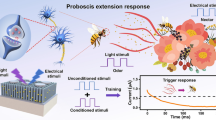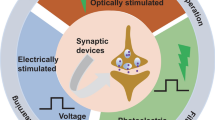Abstract
A mathematical model and a computational method for extracting the inductances and spatial distributions of supercurrents in an adiabatic artificial neuron are proposed. This neuron is a multilayer structure containing Josephson junctions. The computational method is based on the simultaneous solution of the London equations for the currents in the superconductor layers and Maxwell’s equations, which determine the spatial distribution of the magnetic field, and on a model of the current sheet, which accounts for the finite depth of conducting layers and current contacts. This approach effectively takes into account interlayer contacts and Josephson junctions in the form of distributed current sources. The resulting equations are solved using the finite element method with large dense matrices. Computational results for the model of neuron with a sigmoid transfer function are presented. To optimize the device design, both the operating (planned in the first phase of the design) and parasitic inductances and the distribution of currents are calculated. The proposed methodology and software can be used for simulating a wide range of superconductor devices based on superconducting quantum interference devices.




Similar content being viewed by others
REFERENCES
I. I. Soloviev, N. V. Klenov, A. E. Schegolev, S. V. Bakurskiy, and M. Yu. Kupriyanov, “Analytical derivation of DC SQUID response,” Superconductor Sci. Technol. 29 (9), 094005 (2016).
V. K. Kornev, N. V. Kolotinskiy, D. E. Bazulin, and O. A. Mukhanov, “High linearity bi-SQUID: Design map,” IEEE Trans. Appl. Superconductivity 28 (7), 1–5 (2018).
I. I. Soloviev, V. I. Ruzhickiy, N. V. Klenov, S. V. Bakurskiy, and M. Yu. Kupriyanov, “A linear magnetic flux-to-voltage transfer function of a differential DC SQUID,” Superconductor Sci. Technol. 32 (7), 074005 (2019).
H. Katayama, T. Fujii, and N. Hatakenaka, “Theoretical basis of SQUID-based artificial neurons,” J. Appl. Phys. 124 (15), 152106 (2018).
I. I. Soloviev, A. E. Schegolev, N. V. Klenov, S. V. Bakurskiy, M. Y. Kupriyanov, M. V. Tereshonok, A. V. Shadrin, V. S. Stolyarov, and A. A. Golubov, “Adiabatic superconducting artificial neural network: Basic cells,” J. Appl. Phys. 124 (15), 152113 (2018).
N. V. Klenov, A. E. Schegolev, I. I. Soloviev, S. V. Bakurskiy, and M. V. Tereshonok, “Energy efficient superconducting neural networks for high-speed intellectual data processing systems,” IEEE Trans. Appl. Superconductivity 28 (7), 1–6 (2018).
A. E. Schegolev, N. V. Klenov, I. I. Soloviev, and M. V. Tereshonok, “Adiabatic superconducting cells for ultra-low-power artificial neural networks,” Beilstein J. Nanotechnol. 7, 1397–1403 (2016).
M. M. Khapaev, “Inductance extraction of multilayer finite-thickness superconductor circuits,” IEEE Trans. Microwave Theory Techn. 49, 217–220 (2001).
M. M. Khapaev and M. Ya. Kupriyanov, “Inductance extraction of superconductor structures with internal current sources,” Superconductor Sci. Technol. 28 (5), 055013 (2015).
V. V. Schmidt, The Physics of Superconductors: Introduction to Fundamentals and Applications (Springer, Berlin, 2010).
T. P. Orlando and K. A. Delin, Foundations of Applied Superconductivity (Addison–Wesley, 1991).
M. Kamon, M. J. Tsuk, and J. K. White, “FASTHENRY: A multipole–accelerated 3D inductance extraction program,” IEEE Trans. Microwave Theory Techn. 42, 1750–1758 (1994).
A. C. Yucel, I. P. Georgakis, A. G. Polimeridis, H. Bagci, and J. K. White, “VoxHenry: FFT-accelerated inductance extraction for voxelized geometries,” IEEE Trans. Microwave Theory Techn. 66, 1723–1735 (2018).
S. R. Whiteley, Fasthenry 3.0wr. http://www.wrcad.com.
C. J. Fourie and K. Jackman, “Software tools for flux trapping and magnetic field analysis in superconducting circuits,” IEEE Trans. Appl. Superconductivity 29, 1301004 (2019).
V. J. Ervin and E. P. Stephan, “A boundary element Galerkin method for a hypersingular integral equation on open surfaces,” Math. Meth. Appl. Sci. 13, 281–289 (1990).
M. M. Khapaev and M. Ya. Kupriyanov, Sparse approximation of FEM matrix for sheet current integro-differential equation,” in Matrix Methods: Theory, Algorithms and Applications. Dedicated to the Memory of Gene Golub (2010), pp. 510–522.
J. M. Jin, The Finite Element Method in Electromagnetics (Wiley, 2015).
J. R. Shewchuk, “Delaunay refinement algorithms for triangular mesh generation,” Comput. Geom.: Theory Appl. 22, 21–74 (2002).
ACKNOWLEDGMENTS
We are grateful to V. Bol’ginov for fruitful discussions of possible implementations of models of artificial neurons.
Funding
This work was supported by the Russian Science Foundation, project no. 20-12-00130 (the development of numerical algorithms for extracting self- and mutual inductances for superconducting circuits), by the Russian Foundation for Basic Research, project no. 19-02-00981 (the development of a model of superconducting neuron), and by grant MD-186.2020.8 of the President of the Russian Federation.
Author information
Authors and Affiliations
Corresponding author
Additional information
Translated by A. Klimontovich
Rights and permissions
About this article
Cite this article
Bakurskiy, S.V., Klenov, N.V., Kupriyanov, M.Y. et al. Extraction of Inductances and Spatial Distributions of Currents in a Model of Superconducting Neuron. Comput. Math. and Math. Phys. 61, 854–863 (2021). https://doi.org/10.1134/S096554252105002X
Received:
Revised:
Accepted:
Published:
Issue Date:
DOI: https://doi.org/10.1134/S096554252105002X




